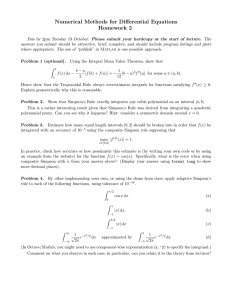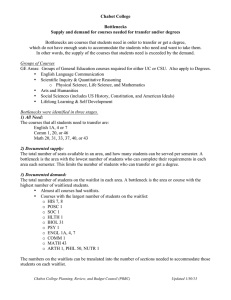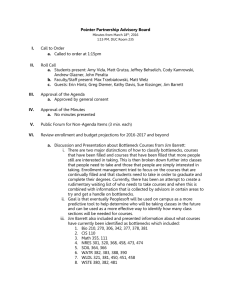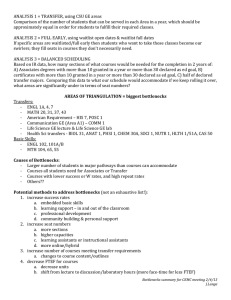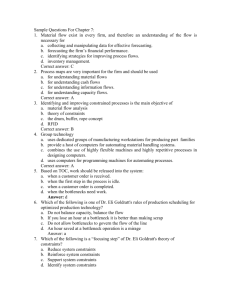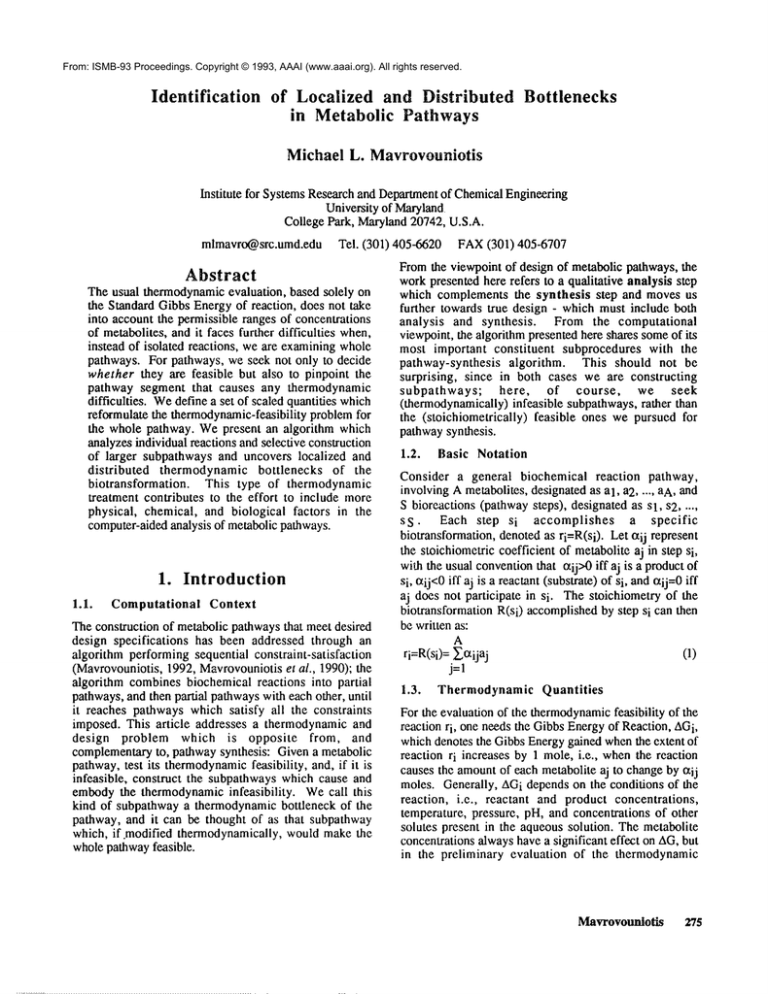
From: ISMB-93 Proceedings. Copyright © 1993, AAAI (www.aaai.org). All rights reserved.
Identification
of Localized and Distributed Bottlenecks
in Metabolic Pathways
Michael L. Mavrovouniotis
Institute for Systems Research and Deparunentof ChemicalEngineering
University of Maryland
College Park, Maryland 20742, U.S.A.
mlmavro@src.umd.edu Tel.
(301)405-6620
Abstract
The usual thermodynamicevaluation, based solely on
the Standard Gibbs Energy of reaction, does not take
into account the permissible ranges of concentrations
of metabolites, and it faces further difficulties when,
instead of isolated reactions, we are examining whole
pathways. For pathways, we seek not only to decide
whether they are feasible but also to pinpoint the
pathway segment that causes any thermodynamic
difficulties. Wedefine a set of scaled quantities which
reformulate the thermodynamic-feasibility problemfor
the whole pathway. Wepresent an algorithm which
analyzes individual reactions and selective construction
of larger subpathways and uncovers localized and
distributed
thermodynamic bottlenecks
of the
biotransformation.
This type of thermodynamic
treatment contributes to the effort to include more
physical, chemical, and biological factors in the
computer-aidedanalysis of metabolic pathways.
1. Introduction
1.1.
Computational
Context
The construction of metabolic pathwaysthat meet desired
design specifications
has been addressed through an
algorithm performing sequential constraint-satisfaction
(Mavrovouniotis, 1992, Mavrovouniotiset al., 1990); the
algorithm combines biochemical reactions into partial
pathways, and then partial pathwayswith each other, until
it reaches pathways which satisfy all the constraints
imposed. This article addresses a thermodynamic and
design problem which is opposite
from, and
complementaryto, pathway synthesis: Given a metabolic
pathway, test its thermodynamic
feasibility, and, if it is
infeasible, construct the subpathways which cause and
embodythe thermodynamicinfeasibility.
Wecall this
kind of subpathway a thermodynamic bottleneck of the
pathway, and it can be thought of as that subpathway
which, if.modified thermodynamically, would make the
whole pathwayfeasible.
FAX(301)405-6707
From the viewpoint of design of metabolic pathways, the
work presented here refers to a qualitative analysis step
which complements the synthesis step and moves us
further towards true design - which must include both
analysis and synthesis.
From the computational
viewpoint, the algorithm presented here shares someof its
most important constituent subprocedures with the
pathway-synthesis
algorithm. This should not be
surprising, since in both cases we are constructing
subpathways;
here,
of course,
we seek
(thermodynamically) infeasible subpathways, rather than
the (stoichiometrically) feasible ones we pursued for
pathwaysynthesis.
1.2.
Basic Notation
Consider a general biochemical reaction pathway,
involving A metabolites, designated as al, a2 ..... aA, and
S bioreactions (pathwaysteps), designated as Sl, s2 .....
ss. Each step si accomplishes
a specific
biotransformation, denoted as ri=R(si). Let ctij represent
the stoichiometric coefficient of metabolite aj in step si,
with the usual conventionthat t~ij>0 iff aj is a product of
si, cqj<0iff aj is a reactant (substrate) of si, andctij=0 iff
aj does not participate in si. The stoichiometry of the
biotransformation R(si) accomplishedby step si can then
be written as:
A
(1)
ri=R(si)= ~cqjaj
j=l
1.3.
Thermodynamic Quantities
For the evaluation of the thermodynamic
feasibility of the
reaction ri, one needs the GibbsEnergyof Reaction, AGi,
which denotes the Gibbs Energygained whenthe extent of
reaction ri increases by 1 mole, i.e., whenthe reaction
causes the amountof each metabolite aj to change by txij
moles. Generally, AGidepends on the conditions of the
reaction, i.e., reactant and product concentrations,
temperature, pressure, pH, and concentrations of other
solutes present in the aqueous solution. The metabolite
concentrations always have a significant effect on AG,but
in the preliminary evaluation of the thermodynamic
Mavrovounlotis
275
feasibility of a reaction the concentrations are not known.
A quantity independentof the actual reaction conditions is
the Standard Gibbs Energy of Reaction, AGi°’, which is
defined in a prespecified standard state (25°C, 1 atm,
pH=7, concentration units IM, dilute aqueous solution).
This standard Gibbs Energycan be estimated, if necessary,
through a group-contribution method (Mavrovouniotis,
1991). Whenall actual conditions, except the metabolite
concentrations, are the sameas the standard conditions, we
°’ with the expression:
can relate AGito AGi
A
(2)
AGi=AGi°’+~[aijRT ln(,jCj)]
j=l
whereR is the ideal-gas constant, T is the temperature, In
is the natural logarithm, Cj is the concentration of aj
(expressedin M), and ~j is the activity coefficient - which
is equal to 1 for ideal systems but may take different
values dependent on the composition of the system.
1.4.
Traditional
Thermodynamic Evaluation
To evaluate the thermodynamicfeasibility of a metabolic
pathway, for a given system with knownconcentrations
Cj and activity coefficients ~j, we simply calculate AGi
for each bioreaction. The step s i is thermodynamically
feasible in the forward direction iff AGi<0.The pathway
is therefore feasible iff AGi<0for all i. In infeasible
pathways,it is likely that most reactions are feasible and
only some particular isolated reactions are infeasible,
posing a thermodynamic bottleneck. Note that in
this analysis each bioreaction is considered separately and
classified as feasible or infeasible. Thus, bottlenecks are
alwayslocalized to single bioreactions.
However,the Cj and ¢~j are usually not fully prespecified.
A commonpractice in this case is to examineinstead of
AGi. If the absolute magnitudeof AGi°’ is large, then a
°’ meansthat the forward reaction is favored,
negative AGi
°’ meansthe reaction is favored only
while a positive AGi
in the reverse direction and forms a bottleneck. If the
absolute value of AGi°’ is small, e.g., less than 4 kJ/mol
(-1 kcal/mol), the reaction can take place in either
direction.
This approach is physically unrealistic because the
°’ are arbitrary and do not
standard conditions of AG
°’
conformto the particular system of interest, since AGi
ignores the actual Cj and ~j completely. The deficiencies
are remedied in this paper by the definition of new
thermodynamicquantities, which are used in algorithms
that identify the localized or distributed thermodynamic
bottlenecks of biochemicallYathways.
1.5.
Objective
The basic question that will be addressed here is the
determination of whether a pathwayis thermodynamically
276
ISMB-93
feasible, and, if it is not feasible, the determinationof the
pathway location where the infeasibility
occurs. We
assume that the available information includes a
description of a metabolic pathway in the form of the
stoichiometries
ctij; the thermodynamics of each
bioreaction si, in the form of the standard Gibbs energy
AGi°’; and a partial description of the permissible
concentrations of each metabolite aj, in the form of an
upper and a lower boundfor ¢~jCj.
Our approach will be based on a transformation of the
thermodynamicquantities. Wenote that transformation of
the Gibbs energy can be useful in using various types of
information about the biochemical environment, such as
the pH and pMg(Alberty, 1992a and 1992b, and references
therein).
2.
Transformation of the Problem
2.1.
Bounds on Metabolite
Concentrations
For each metabolite, we assumethat we have an upper and
lower hound either for the product q~jCj or for the
quantities Cj and ~j separately. Weindicate these bounds
with the superscripts max and rain. The bounds are
assumptions which define the spectrum of systems for
which the analysis will be applicable. Wewill introduce
parameters which will recast the thermodynamic
requirements in a new form which takes into account the
concentration limits of the metabolites.
First, we must accord special treatment to the sct K of
metabolites whose concentrations are fixed, i.e.,
d~’maxc’max-’~’minc’min
j
j
-vj
j
- These will commonly
include [HI+I and [OHI-]. For the purposes of
thermodynamic analysis, these metabolites can be
eliminated from the stoichiometry and all the algebraic
expressions we will use, by rewriting AGiin the form:
AGi=AGi°’+~[eqjRTin(~jCj)]+ ]~[aijRTIn(¢jCj)]
aj~K
Wethen replace AGi°’ by the first two terms in the righthand side, and we redefine the stoichiometries and
concentrations (and summations which involve them)
include only the species aj~ K. In the sequel, we will
assume this step has been taken, so that we can assume
that all (remaining) metabolites have concentrations
varying within an interval of non-zero, finite span.
2.2.
Scaling
For each metabolite aj, wc replace the concentration by a
newscaled activity parameterfj, defined as:
"]
(4)
Ij=(In..mi~dC!m in~/(,n~.~c!m~n
\
vj
J
)l\
J J /
This activity parameterexpresses the relative location of
the ¢jCj in the interval (¢jmincjmin, ¢jmaxcjmax),
using a log scale because of the form of Eq. (2). For each
bioreaction st, we replace the standard Gibbs energy by the
newparametergi, defined as:
A
gi=AGi°’ +E [cqjln(~jmincjmin)]
(5)
j-1
Aside from a scaling by RT, this is merely the Gibbs
energy in another standard state: Each metabolite is
assumed to have its minimumpermissible concentration
rather than a predeterminedvalue (such as the 1 Mused in
AGi°3.
Finally, we transform the stoichiometric coefficients cqj
as follows:
9jmaxcjmax
(6)
wij=oqj In ¢imincjm in
The scaled stoichiometries wij have the same signs as cxij
and they therefore preserve connotations such as wij<0 iff
metabolite aj serves as a substrate for step st.
Furthermore, because the factor scaling aij to produce wij
in Eq. (5) did not depend on i, if we choose to combine
two reactions we can combine their wij the same way we
wouldcombinectij. In effect, wij has all the properties of
reaction stoichiometries and can be viewed as nothing
more than a redefinition
of the mole unit of each
compound.Fromthe definitions of fj and wij, note that:
¢ici .
(7)
cXij cjmmcjmm =wijfj
Given the standard Gibbs energies and the stoichiometries
of all steps as well as the concentration bounds of all
metabolites, the parameters gi and wij can be uniquely
computed. The scaled activity parameters fj cannot be
computed, but they are constrained by the permissible
concentration values:
(8)
0 _<fj -< 1
2.3.
Conditions
in the Scaled
Parameters
With these transformed variables, the condition that a
pathway-step si is thermodynamically feasible (in the
forwarddirection) iff the Gibbsenergyof the reaction ri is
negative is equivalent to:
A
.
o, A
¢jCj
1<
AGi..±x-’r,,,..lnr,~.minc,.min~l+X’r,.,..ln
0
RT1-/_.,tt.~.lj,,,~Ot,
.,..j
jj
/..~t,.~lj
qb.minc.minJ
j=l
j
j=l
J j
(9)
The first two terms of the above sumare the definition of
gi, while each term under the rightmost summation is
equal to wijfj, as was remarked earlier. Therefore, the
thermodynamiccondition becomes:
A
gi + ~wijfj < 0
j=l
(10)
Taking g and f to be columnvectors of dimensions S and
A respectively, and Wa matrix of dimensions SxAwith
entries wij, we can write the condition (10) for all i
matrix form:
g+Wf<0, f’e0,
f<b
(11)
where b=[1 1 ... 1]T is a columnvector of dimension A.
With Wi denoting row i of the matrix W, we define the
function H for an isolated reaction ri:
A
(12)
H(ri,f) = gi + Wif = gi+ ~wijfj
j=l
Wecan then write the separate condition for the feasibility
of eachri:
H(ri,f) < 0, f’e_0, f<_b
(13)
2.4.
Feasibility
of a Single Reaction
The thermodynamicevaluation of a single reaction entails
using the selected concentration bounds to compute the
upper and lower bound of the Gibbs energy. The signs of
these bounds reveal quantitatively the feasibility and
reversibility of the reaction. The analysis can be done
either d~J~ecdywith the unscaledparameters(Eq. 2), or after
various stages of scaling.
While the scaling does not affect the sign of the Gibbs
energy (and hence the signs of its upper and lower
bounds), it does affect the interpretation
of the
sensitivity of the result, which is dependent on the
magnitudes of the bounds. To obtain a useful scaled
result, and to set the stage for the analysis of whole
pathways, let Hmax(ri) and Hmin(ri) be defined, for
given reaction ri, as the constrained optima:
(14)
Hmax(ri)=m~¢
H(ri,f), subject to 0~:_f<b
,g
Hmin(ri)=m~n
H(ri,f), subject to 0~:_f<_b
If weare viewingone reaction in isolation, each variable fj
can vary between 0 and 1, completely independently from
the others. Therefore, the maximumvalue of H is
obtained by selecting fj=l whenever wij>0, and fj=0
wheneverwij<0 (the value of fj is, of course, irrelevant
when wij=0). Similarly, the minimumvalue of H can be
obtained by selecting fj=l whenever wij<0, and fj--0
whenever wij>0. Thus:
Hmax(ri)=gi+ ~ wij and Hmin(ri)=gi+
~ wij (16)
J
J
(wij>0)
(wij<0)
A very simple criterion for the thermodynamicfeasibility
of an isolated metabolicstep si is:
Hmin(ri)<0
(17)
Mavrovouniotis
277
The quantity Hmin(ri) represents the scaled Gibbs energy
whenall concentrations take their most favorable values
(for si). The scaling permits Hmin(ri) to be interpreted
the most favorable distance from equilibrium that the
reaction can attain. Hmax(ri), on the other hand is the
least favorabledistance; if it is also negative, the reaction
is thermodynamicallyfeasible (and irreversible) for all
concentrations in the specified bounds.
Note, however, that for a whole set of bioreactions to be
feasible simultaneously (i.e., in the same system) the
conditions H(ri,f)<0 must be satisfied simultaneously
using the same vector f. Therefore, testing the Hmin(ri)
of each reaction is a necessarybut not sufficient condition.
2.5.
Thermodynamic Bottlenecks
Wecan express the thermodynamicconditions in terms of
reaction combinations as follows. Since the function H
applies to isolated bioreactions, we also let it apply to a
linear combination of reactions, er, where e is a row
vector of dimension S, containing the combination
coefficients used in formingthe compositereaction.
H(er,f) = eg+eWf
(18)
where eWequals the stoichiometry of the reaction er. We
will permit only non-negative entries in this combination
vector e, because a negative entry has the effect of
reversing a reaction; we will also exclude the trivial zero
vector. These restrictions on e will apply throughout this
paper, even whenthey are not explicitly mentioned.
e>0 and e¢0
(19)
The sign of H(er,f) showswhether the linear combination
of reactions er is feasible when viewed as an overall
transformation. If Vsi H(ri,f)>0, given that e_>0,
can clearly conclude that H(er,f)>0, since by Eq. (16)
cannot be the trivial zero vector; howeverthe converse is
not true.
We now return to the question of thermodynamic
bottlenecks,
which we seek whenever a pathway is
thermodynamically infeasible.
In order to define
bottlenecks, we require that the bounds on f always be
satisfied and considering subsets of the set of inequalities
H(ri,0<0. If the pathwayas a whole is not feasible, then
some of these subsets will be feasible (i.e., will be
satisfiable by somet) and somewill not. A set of steps
forms an infeasible subpathwayiff for any f in the range
0’L:_f_<b
at least onestep in B is not feasible:
Vf 3 0’£_f_<b: 3sic B 3 H(ri,f)>0
(20)
If a subpathway contains (as a subset) an infeasible
subpathway, then it is also infeasible. A bottleneck is
a minimal infeasible subpathway, i.e., a set B which is
infeasible and does not have any infeasible proper subsets.
Thus, bottlenecks are defined by minimality (with respect
to inclusion) in the class of infeasible subpathways.
bottleneck B is localized if it is a singleton set, and
distributed if it involves two or more steps. The reason
that distributed bottlenecks exist is that a numberof
inequalities of the form(1) maybe unsatisfiable as a set,
even thougheach inequality is separately satisfiable: The
sets of vectors f that satisfy the inequalities separately are
disjoint.
An infeasible pathwaycan have several bottlenecks, with
different numbersof reactions, because a bottleneck is
minimalonly with respect to inclusion - not cardinality.
2.6.
Conversion to the Dual Problem
Since for feasibility we require H(ri,f) to be negative for
every i (with the same vector f), we can recast the
condition equivalently as follows. There must exist a
vector f (0~:_f_<b)such that for all reaction combinations
(subject to Eq. 19), we have H(er,f)<0. To showthat
follows from the condition (13) we simply multiply each
H(ri,f) by ei and sumup the results, noting that H(er,f)
a linear function with respect to e. Conversely, to show
that the new condition leads back to (13), we simply use
¯
A
as e each of the unit-vectors ei of the S-dimensionalspace
of rowvectors, %1=[10 0 0...], %2=[01 0 0 ...], %3=[00 1
0 ...],
etc. With this explanation we write our
reformulated condition mathematically, as:
q f (0~_f<b): Ve-2_0 H(er,0<0
(21)
The algorithm for the construction of the bottlenecks is
based on the conversionof this condition to its equivalent
dual form:
Ve,-20 3f (0~_f<_b): H(er,f)<0
i.e., any reaction vector er in the convexcone spannedby
the reactions
must lead to a feasible
overall
transformation. Wehasten to add that reversing the order
of the two quantifiers is a significant transformation. To
find an f such that all of the combinationser are feasible
(with that fixed f) is conceptually a different operation
from making each combination feasible by finding an f
specific to that combination. The values of H(er,f)
resulting from the two forms of the condition, for a given
e, will not necessarily be the same. However,it can be
shownthrough the theory of linear inequalities that the
two conditions are equivalent.
Given any e_>0, we let vj represent the stoichiometric
coefficient of species aj in the reaction er. Clearly:
v=eWand H(er,f)=eg+vf
(23)
The definitions of Hmaxand Hmin, applied to a combined
reaction er are the sameas those for an isolated reaction ri.
Wehave:
Hmax(er)=m~axH(er,~g+meax
(vf), subject to 0£:_f_<b
Hmin(er)=r~inH(er,f)=eg+mfin
(vf), subject to 0~_f<b
Again, for a fixed reaction er, the variables fj can vary
278
ISMB-93
independently between 0 and 1. Therefore, the value of
H(er,f) is obtained by selecting fj=l whenevervj>0, and
fj=0 whenevervj_<0; the minimumof H(er,f) is obtained
by selecting fj-- 1 whenevervj<0, and fj=0 wheneverv j_>0.
Thus:
(26)
Hmax(er)=eg+ ~vj and Hmin(er)=eg+
v j>0
v j<0
i.e.,
Hmin(er)<0. If we form e"=e’+e,
combinationbe a bottleneck?
Using the definition of Hmin, we can rewrite the dual
form of the necessary and sufficient requirement for
pathwayfeasibility as:
Ve20:Hmin(er)<0
(27)
Therefore, the combination of a subpathway for which
Hmax(er)<0 and a subpathway which is feasible cannot
lead to an infeasibility. The consequenceis that we can
eliminate from the active set combinations that have
Hmax(er)<0 (which actually involve irreversible
transformations).
A pathwaywhosereaction vector is r is not feasible iff:
3e20:Hmin(er)>0
(28)
A pathwayis irreversible (and feasible) over the entire
space of permissibleconcentrationif f:
Ve_>0:Hmax(er)<0
(29)
2.7.
Bottlenecks
in the Dual Form
Wenow return to the definition
of thermodynamic
bottlenecks,
which occur only if a pathway is
thermodynamically infeasible.
In the dual form, an
infeasible subpathwayis formedby the steps in a set B iff
there is a combinatione which is infeasible and contains
only reactions from B; mathematically:
3e.20: (si~ B: ei=0) and Hmin(er)>0
B is a bottleneck if it is a minimalinfeasible subpathway,
i.e., there is no infeasible subpathwayusing a subset of
the steps used by B.
It is convenient to declare the vector e itself as the
bottleneck, rather than the associated set B, and we will do
so in the rest of this paper. The step si of a pathway
forms a localized thermodynamic bottleneck Aei iff
Hmax(ri)<0- in effect, the reaction is infeasible on its
own. A distributed bottleneck occurs when e has more
than one non-zero components.
3.
3.1.
Construction of Bottlenecks
Selection
of Constraining
Subpathways
The problemof deciding the feasibility of a pathwaywas
reduced to examiningall linear combinationsof reactions,
which is clearly impractical. In the proposed method, the
active set of subpathways includes only pathways which
are feasible. These are successively combinedin pairs to
produce an infeasibility.
It turns out that most
combinations can be ruled out of potential bottlenecks,
based on the additivity properties of H. Supposethat for
somee we have Hmax(er)<0- therefore for all acceptable
we must have:
H(er, f)<0
(31)
Let also e’ be a thermodynamicallyfeasible combination,
can this
Wehave, from the linearity of H"
n(e"r,f)=H(er,f)+H(e’r,f)
(32)
and using Eq. (31) we conclude:
H(e"r,f)<H(e’r,t) ~ Hmin(e"r)<Hmin(e’r)
(33)
To focus on a second important consideration, suppose
that two reactions, rl and r2, are linearly combined,with
coefficients tl>0 and t2>0, into an aggregate reaction,
r3=tlrl+t2r 2. Letting 13ij represent the scaled coefficient
of metaboliteaj in reaction ri, the coefficients of the three
reactions are interrelated as follows: 133j=tl131j+t2132j.
Their scaled Gibbsparameters gi are likewise interrelated
as g3=tlgl+t2g2. Therefore, through the definition of H,
we have H(r3,f)=tlH(rl,f)+t2H(r2,f).
The values
Hmin(r3) and Hmax(r
depend
on
the
choice
of favorable
3)
values (0 or 1) for each fj. The Hminand Hmaxof rl and
r2 will combinelinearly (just like H), unless the reactions
r 1 and r 2 share a metabolite in a way that contradictory
choices for some fj have to be made, i.e., unless some
metabolite aj is a product of one reaction and a reactant of
the other. If this kind of shared metabolite exists, then
Hmin(r3) will be higher than the linear combination
tl Hmin(rl)+t2Hmin(r2),and Hmax(r3)will be lower
tl Hmax(rl)+t2Hmax(r2). Furthermore, the discrepancy
will be most drastic if the coefficients tl and t2 are
selected so that 133J=0for the shared metabolite aj; this
choiceof coefficients is actually tl=l132jl and t2=l131jl.
3.2.
Algorithm
The algorithm for the construction of the bottlenecks is
based on the dual formof the criteria and the observations
in the previous section. Wemaintain all the candidate
bottlenecks in a list L, and the provenbottlenecks in a list
LB, and we introduce tests to avoid duplication of entries
in these two lists. Werepresent each bottleneck as a
vector e, whoseoverall reaction is er=R(es). The initial
list of candidate bottlenecks consists of all individual
reactions(~i).
The algorithm’s operation is described in Figure 1, inthe
simplest possible form of the algorithm, without
worrying about efficiency-enhancing details of the
implementation. For example, in the computation of
Hmaxand Hminfor all reactions one can postulate a
number of improvements: The parameters can be
Mavrovouniotis
279
computed when a new combination e is constructed, from
the corresponding parameters of the componentsused in
the combination. The computation of Hmax can be
avoided if Hmin turns out to be positive; or the
computation of Hmin can be avoided if Hma
x turns out to
be negative; or we can compute both simultaneously. We
are also not addressing the important issue of organizing
the search (from its current breadth-first mode)to a more
efficient arrangement in which the most promising leads
are exploredfirst.
A
Initialize LB:= ~ and L:={ ei, i=1,2 ..... S}
Repeat until L=~:
For each e~ L:
Compute Hmax and Hmin
If Hmin(er)>0then:
Set L:=L-{e}
If e is not a subpathwayof a pathwayin LBthen:
Set LB:=LBU{e}
Else if Hmax(er)<0,set L:=L-[e}
Let L":=~
For each e~ L determine the corresponding v=eW
Foreach j=l ..... A
For each eEL which has a coefficient vj>0 do:
For each e’c L such that its v’j<0 do:
Let e"=(vje’-v’je)/(vj-v’j)
If e" is not a subpathwayof a pathwayin L" then:
Set L":=L"w{e"}
Set L:=L"
Output LB (minimal bottlenecks)
Figure 1: The operation of the algorithm for the
identification of bottlenecks.
4.
An Example
Wewill analyze the glycolysis pathway (Figure 2)
illustrate the construction of localized and distributed
thermodynamic bottlenecks.
Table 2 shows the
bioreactions and standard Gibbs energies, as given by
Lehninger (1982).
We note that the traditional
way of assessing
thermodynamic feasibility,
through the signs of the
standard Gibbs energies in Table l, would be quite
°’ whereinterpreted
misleadinghere: If all the positive AG
as infeasibilities, then this central pathwaywouldbe ruled
infeasible!
We assume, for simplicity,
that T=298.15K (25°C),
pH=7, and ¢~j=l for all j, and we focus on the
concentration
bounds. For the energy-currency
metabolites (ADP,ATP, and Pi) we will assume constant
concentrations and use the values given by Lehninger
(1982, p. 373), for E.Coli: 0.82mM (AMP), 1.04mM
(ADP), 7.9mM(ATP), 7.9mM(Pi). Lchninger’s
280 ISM.B-93
correspond to an Energy Charge of approximately 0.87,
which is consistent with the range stated by Ingrahamet
al. (1983, p. 166). For NADand NADH,we use the
range 0.03-0.07 given by Ingrahamet al. (1983, p. 168)
for the Catabolic Reduction Charge of growing E.Coli,
and we assume the concentration
of NAD to be
approximately
constant at 4mM. This gives the
concentration of NADH
in the range 0.12mM-0.28mM.
Wewill assume that the remaining metabolites share the
same concentration
range, Cmin<Cj<Cmax; we will
examinea numberof possibilities for this concentration
range.
-3 M ,
First
Interval:
Cmin=0.1xl0
-3
Cmax=IXl0
M. The computations
are shown in
Table 2. Applying the algorithm, we first assume each
individual bioreaction to be a candidatebottleneck; in other
words, the subpathwaysthat are potential bottlenecks are
A
We compute the
simply the unit vectors
e i.
A
A
Hmin(eir)=Hmin(ri) and Hmax(eir)=Hmax(ri).
reject all subpathways that have Hmax(~ir)<0. This
immediately deletes subpathways 1, 3, 7, 10, 11.
Physically, each of these bioreactions is always feasible
and irreversible within the assumedconcentration bounds;
thus, not only is it not a bottleneck by itself, but it could
also never be part of a distributed bottleneck.
In the same round, we identify as bottlenecks all those
A
subpathways for which Hmin(eir)>0. This shows
bioreactions 5 and 6 to be localized bottlenecks.
Continuing, we examine the remaining subpathways (2,
A
4, 8, and 9) for which Hmin(eir)<0<Hmax(~ir), and
construct all combinationsof two subpathways(from this
set) such that one intermediate is eliminated. Only one
A
such combination is possible, e8+e9. This completes one
A A
iteration of the algorithm; at this point, LB={e5, e6} and
A A
L={e8+e9}.
In the next iteration,
we compute g8+g9=2.533 and
Hmin(r8+r9)=0.23>0.The combination r8+r9 is therefore
a distributed bottleneck. There is for each of r 8 and r 9 a
portion of the permissible concentration space that leads to
a negative AGand make the reaction feasible. However,
there is no overlap between these two portions of the
concentration space. Our formulation addresses this by
showingthat the overall reaction r8+r9 (whichis 3PG--->
PEP)is never feasible in the given concentration space.
^ ^
The final result is LB={~5,~6,e8+e9}.
Note that r4,
which had the largest (most unfavorable) °’ , ac tually
does not occurin a bottleneck at all!
Second Interval:
Cmin=0.1xl0 -3 M ,
-3
Cmax=2xl0
M. With Cmax relaxed to2xl0 -3 M
(the new parameters shownin Table 2) the application
the algorithm follows the same route as before, and
bioreactions 5 and 6 clearly remain localized bottlenecks.
The only difference arises when we compute, for the
A A
combination r8+r9:g8+g9=2.533 and Hmin((e8+e9)r)=^ ^ cannot be
0.463<0. Thus, the subpathway e8+e9
classified as a bottleneck, but neither can it be rejected
A A
right away, because Hmax((e8+e9)r)=5.529>0.
We
therefore proceed to the algorithm phase that constructs
combinations.
However, no combinations
can be
constructed, and therefore the final result involves just two
A A
localized bottlenecks: LB--{e5, e6}.
they are rejected; note that although it is possible to
A
A
^
A
combine e4+e 5 and e4+e6 this combination already
A ^
contains a bottleneck (e5+e6) and is therefore not new.
The
5 relaxation of the concentration interval eliminated r
and r 6 as localized bottlenecks, but it gave rise to their
combination,r5+r6, as a distributed bottleneck.
-3 M,
Fourth Interval:
Cmin=0.004xl0
-3
Cmax=5xl0
M. With these bounds, the three^
~^
reaction combination^e4+e5+ze
6 is found to be the only
bottleneck:
^
^
A
g4+g5+2g6=8.069,Hmin((e4+
e5+2
e6)r)=0.938>0
Third
Interval:
Cmin =0.02x10-3
M ,
-3
Cmax=4xl0
M. Relaxing both concentration
bounds further we see that there are no longer any
individual reactions with Hmin(ri)>0 (Table
Therefore, in the first iteration, no localized bottlenecks
^
are uncovered, but L={~e4,
^ ^e8, ~9} remains for
2, e5,^ e6,
possible distributed bottlenecks. The combinations that
A
^
^
^
^
^
are constructed are: L"={(es+e9), (e4+e5), (e4+e6),
(~5+~6)}. For these can then compute:
g8+g9=2.533,
^
Hmin((Ae8+
e9)r)=_2.765<0,Hmax((e8+e9)r)=7.831
g4+g5=1.944,
A
Hmin((Ae4+
e5)r)=_3.354<0,Hmax((e4+ e5)r)= 12.54>0;
g4+g6=2.721,
^
^
^
A
Hmin((e4+e6)r)=-2.577<0, Hmax((e4+e6)r)= 14.164>0;
g5+g6=6.957, Hmin((~5+~6)r)=1.659>0.
This is the first time that r4 appears in a bottleneck! The
analysis suggests that the composite transformation
r4+r5+2r 6, which yields FruDP+2 NAD+2Pi ---)
PGP+2NADH,is the most difficult thermodynamically.
In order to take place, it requires FruDPto have the
maximum and PGP the minimum possible
concentrations. Furthermore, it points to the crucial role
of the Catabolic Reduction Charge, which is the ratio
NADH/ (NAD+NADH).
Fifth Interval:
Cmin=0.0025x10 -3 M ,
-3
Cmax=5xl0 M. The elimination of all distributed
bottlenecks is accomplished if Cminis lowered to the
value 0.0025x10-3 M(i.e., 2.5l.tM). In this case,
obtain:
^
^
^
Hmin((e4+e5+2e6)r)=-0.003<0
^ ^ is a distributed bottleneck, while es+e
Thus, e5+e6
9,^ ^
A A
A ^
e4+e5, and e4+e6 must be examinedfurther. But since no
^
A
^
^
new combinations can be created from es+e9 and
5 e4+e
ATP
ADP
Hexokinase
A
PG-mutase
~E
NAD
ADP NADH
PG-kinase
nolase
ADP
ATP
PEP-~-,--,~
Pyr-kinase
PhosphoFructoKinase
GIc6P-isomerase
3PG~PGP
<~
J
ruDP
P~" AId°las~~,A
,/v
~ GAP~ .........
GAP-dehydrogenase
NADHNAD
Pyr.
ADP
ru,P
o,c,P
ATP
2PG
ATP
/
"~
DHAP
Triose-P-isomerase
~Lac
cac-oehydrogenase
Figure 2: The glycolysis
pathway.
Mavrovouniotis
281
Table 1: Indices, enzymenames, and stoichiometries for the biotransformations comprising glycolysis (also shownin
Figure 2). Water, l+ (or H301+) and O1- have been omitted fr om the st oichiometries. Th e bi ological st andard Gibbs
energies, as given by Lehninger(1982) are also shown.
Index
1
2
3
4
5
6
7
8
9
10
11
Stoichiometry
°~
AG
(kcal/mol)
GIc+ATP --> GIc6P+ADP
- 4.00
GIc6P---> Fru6P
0.40
Fru6P+ATP ~ FruDP+ADP
- 3.40
FruDP ---> DHAP+GAP
5.73
DHAP---> GAP
1.83
GAP+NAD+Pi---> PGP+NADH
1.50
- 4.50
PGP+ADP---> 3PG+ATP
1.06
3PG---> 2PG
2PG---> PEP
0.44
PEP+ADP---> Pyr+ATP
- 7.50
Pyr+NADH--~ Lac+NAD
- 6.00
Name
Hexokinase
Glucose-6-phosphate Isomerase
Phosphofructokinase
Fructose Diphosphate Aldolase
Triose-phosphate Isomerase
Glycemldehyde-phosphateDehydrogenase
Phosphoglycerate Kinase
Phosphoglycerate Mumse
Enolase
Pyruvate Kinase
Lactate Dchydrogenase
"fable 2: Computationsof individual reaction parameters, for various bounds Cminand Cmax.
First Interval:
Second Interval:
Third Interval:
-3
-3
Cmin=0.1×10
M
Cmin=0.1×10
M
Cmin=0.02×10 -3 M
-3
-3
Cmax=l×10
M
Cmax=2×10
M
Cmax=4×10 -3 M
Index
gi
gi
gi
Hmin(ri) Hmax(ri)
Hmin(ri) Hmax(ri)
Hmin(ri) Hmax(ri)
1
-8.781
-11.083
-6.478
-8.781
-11.777
-5.785
-8.781
-14.079
-3.483
2
0.675
-1.627
2.978
0.675
-2.320
3.671
0.67.’
-4.623
5.974
3
-7.768
-10.070
-5.465
-7.768
-10.764
-4.772
-7.76~
- 13.066
-2.470
4
0.464
-1.839
5.069
0.464
-2.532
6.455
-1.141
-6.444
9.451
5
3.090
0.787
5.392
3.090
0.094
6.085
3.094
-2.209
8.388
1.564
7.017
6
3.867
3.867
0.871
7.710
3.86
-1.432
10.012
7
-7.872
-5.570
-3.267
-5.570
-8.565
-2.574
-5.570
-10.868
-0.271
I
1.790
4.092
1.790
-3.509
7.088
8
-0.513
- i .206
4.785
1.790
I
I
0.743
-1.560
3.045
0.743
-4.555
6.041
9
-2.253
3.739
0.743
I
I
10
-10.635
-12.937
-8.332
-10.635
- 13.630
-15.933
-5.336
-7.639[ -10.635
I
11
-6.623
-9.773
-4.321
-6.623
-10.466
-1.325
-3.6281 -6.6231 -12.769
5.
Concluding
Remarks
The methodologypresented in this paper clarifies the
thermodynamicconcepts relevant to the feasibility and
reversibility of biochemical reactions. Furthermore, it
allows the analysis of biochemical pathways, identifying
both localized and distributed bottlenecks. The analysis
can be used to reject proposed pathwaysfor the production
of a bioproduct, whenthey are shownto be infeasible. It
can also be used to comparealternative pathways,to select
the one that presents fewer or less serious bottlcnccks.
Identification of the bottlenecks mayalso be the first step
in a search for improvements that would bypass the
thermodynamic
difficulties.
282
ISMB-93
Acknowledgments
This workwas supported in part by the National Institutes
of Health (National Library of Medicine grant 5 R29 LM
05278-02), and by the Institute for Systems Research
(NSF grant CDR-8803012). The author is grateful
Gregory Stephanopoulos (M.I.T.) and Michael Liebman
(Amoco Technology Co.) for their comments and
encouragement.
References
Alberty, R.A. Equilibrium Calculations on Systems of
Biochemical Reactions at Specified pH and pMg.
Biophysical Chemistry 42, 117-131, 1992a.
Alberty, R.A. Calculation of Transformed
Thermodynamic
Properties of Biochemical Reactants at
Specified pH and pMg. Biophysical Chemistry 43,239254, 1992b.
Mavrovouniotis, M. L., Stephanopoulos, G., and
Stephanopoulos, G. Computer-Aided Synthesis of
Biochemical Pathways. Biotechnology and
Bioengineering, 36, 1119-1132, 1990.
Ingraham, J.L., MaalCe,O., and Neidhardt, F.C. Growth
of the Bacterial Cell. Sinauer Associates, Sunderland,
Mass., 1983.
Mavrovouniotis, M. L. Estimation of Standard Gibbs
Energy Changesof Biotransformations. Journal of
Biological Chemistry, 266, 14440-1~445, 1991.
Lehninger, A.E. Biochemistry, 2nd ed. Worth
Publishers, NewYork, 1975.
Mavrovouniotis,M. L. Identification of Qualitatively
Feasible Metabolic Pathways.In Artificial Intelligence
and Molecular Biology, L. Hunter (editor), AAAIPress
/ MITPress, in press, 1993.
Mavrovouniofls
283

